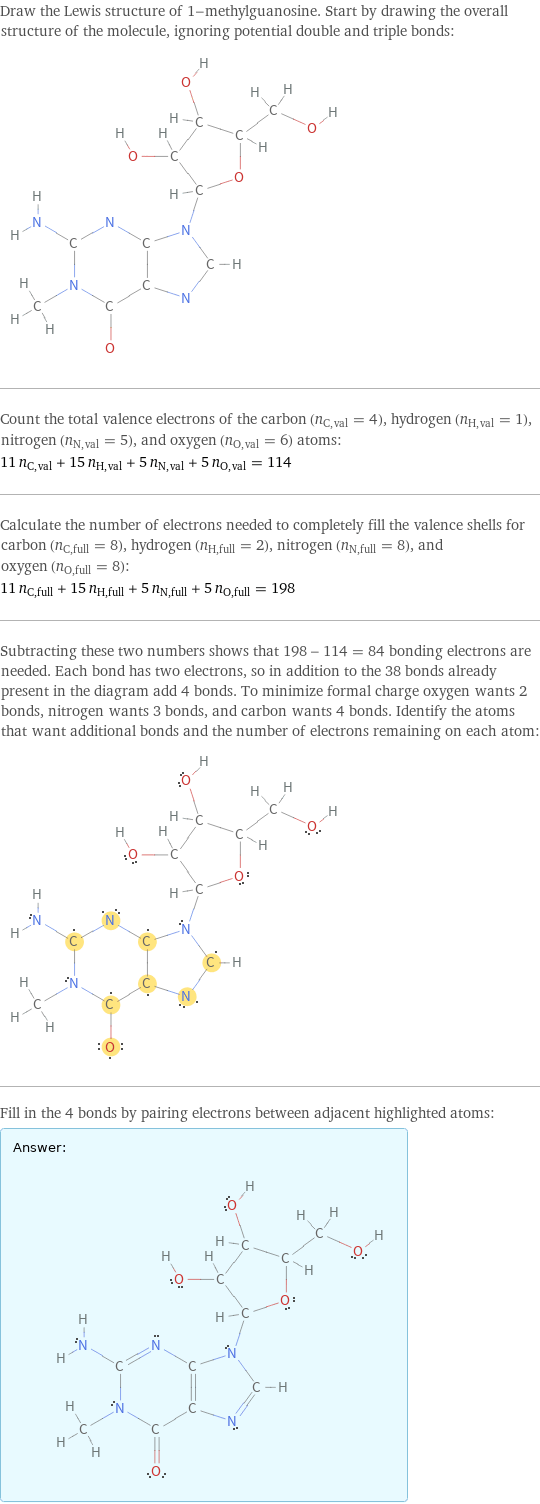Input interpretation

1-methylguanosine
Chemical names and formulas
![formula | C_11H_15N_5O_5 name | 1-methylguanosine IUPAC name | 2-amino-9-[(2R, 3R, 4S, 5R)-3, 4-dihydroxy-5-(hydroxymethyl)-2-tetrahydrofuranyl]-1-methyl-6-purinone mass fractions | C (carbon) 44.4% | H (hydrogen) 5.09% | N (nitrogen) 23.6% | O (oxygen) 26.9%](../image_source/2487ebd7622832f4d08167beb972ac0b.png)
formula | C_11H_15N_5O_5 name | 1-methylguanosine IUPAC name | 2-amino-9-[(2R, 3R, 4S, 5R)-3, 4-dihydroxy-5-(hydroxymethyl)-2-tetrahydrofuranyl]-1-methyl-6-purinone mass fractions | C (carbon) 44.4% | H (hydrogen) 5.09% | N (nitrogen) 23.6% | O (oxygen) 26.9%
Lewis structure

Draw the Lewis structure of 1-methylguanosine. Start by drawing the overall structure of the molecule, ignoring potential double and triple bonds: Count the total valence electrons of the carbon (n_C, val = 4), hydrogen (n_H, val = 1), nitrogen (n_N, val = 5), and oxygen (n_O, val = 6) atoms: 11 n_C, val + 15 n_H, val + 5 n_N, val + 5 n_O, val = 114 Calculate the number of electrons needed to completely fill the valence shells for carbon (n_C, full = 8), hydrogen (n_H, full = 2), nitrogen (n_N, full = 8), and oxygen (n_O, full = 8): 11 n_C, full + 15 n_H, full + 5 n_N, full + 5 n_O, full = 198 Subtracting these two numbers shows that 198 - 114 = 84 bonding electrons are needed. Each bond has two electrons, so in addition to the 38 bonds already present in the diagram add 4 bonds. To minimize formal charge oxygen wants 2 bonds, nitrogen wants 3 bonds, and carbon wants 4 bonds. Identify the atoms that want additional bonds and the number of electrons remaining on each atom: Fill in the 4 bonds by pairing electrons between adjacent highlighted atoms: Answer: | |
Basic properties

molar mass | 297.27 g/mol
Units

Chemical identifiers

PubChem CID number | 96373 SMILES identifier | CN1C(=O)C2=C(N=C1N)N(C=N2)C3C(C(C(O3)CO)O)O InChI identifier | InChI=1S/C11H15N5O5/c1-15-9(20)5-8(14-11(15)12)16(3-13-5)10-7(19)6(18)4(2-17)21-10/h3-4, 6-7, 10, 17-19H, 2H2, 1H3, (H2, 12, 14)/t4-, 6-, 7-, 10-/m1/s1